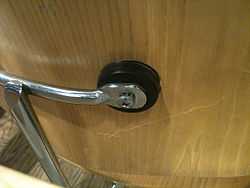Shock mount

In a variety of applications, a shock mount is a mechanical fastener that connects two parts elastically. They are used for shock and vibration isolation.
Design
Rubber bushings compress synthetic rubber rings on bolts to provide some isolation. Other shock mounts have mechanical springs or an elastomer (in tension or compression) engineered to isolate an item from specified mechanical shock and vibration. Some form of dashpot is usually used with a spring to provide viscous damping. Viscoelastic materials are common. Maxwell and Kelvin–Voigt models of viscoelasticity use springs and dashpots in series and parallel circuits respectively. Hydraulic and pneumatic components can be included, depending on the use.[1]
Microphone mount
For a microphone a shock mount helps reduce noise from the surrounding area, without affecting the sound of a microphone. Shock mounts are commonly used on studio microphones to prevent unwanted noise. The shock mount is used to partially isolate the mic from vibrations that might otherwise be transmitted through the mic stand, causing unwanted sounds to be added to the output signal.
In order to avoid microphonism, particularly in the input stages of high-gain amplifiers, design engineers used to shock-mount the tube-socket assemblies in these stages by means of small rubber grommets placed in the screw holes, leaving them in a "floating" situation.[2][3]
Mounting machinery
Machinery may have flexible mounts to help control vibration and reduce noise. Automobile engines usually have flexible mounts to reduce operating noise.
Naval ships have special shock mounts to minimize machinery noise being transmitted to the water. The shock mounts help protect the shipboard operating equipment from the shock of explosions.
Disc drives
Shock mounts are found in some disc drives and compact disc players, in which soft bushings are all that mechanically hold the disk and reading assembly, thereby isolating it from outside vibrations and from other outside loads such as torsion.[4]
Other

Shock mounts can be found in a wide variety of applications.
A similar idea, also known as a shock mount, is found in furniture design, introduced by Charles and Ray Eames. This provides some shock absorption and serves as a living hinge, allowing the seat back to pivot.
Shock mounts are also used in bicycle seats.[5]
See also
References
- ↑ US 3598353, De, GRP, "Air-damped shock mount", published 10 August 1971
- ↑ Granino Arthur Korn; Theresa M. Korn (1956). Electronic analog computers (d-c analog computers). McGraw-Hill. Retrieved 17 April 2013.
- ↑ Electronics. McGraw-Hill Publishing Company. July 1956. Retrieved 17 April 2013.
- ↑ US 5,761,031, Ajmani, R S, "Conductive shock mount for reducing electromagnetic interference in a disk drive system", issued 2 June 1998
- ↑ US 6019422, Taormino, J S & Caselli, "Laterally pivoting bicycle saddle mount with shock absorber", published 1 Feb 2000
- DeSilva, C. W., "Vibration and Shock Handbook", CRC, 2005, ISBN 0-8493-1580-8
- Harris, C. M., and Peirsol, A. G. "Shock and Vibration Handbook", 2001, McGraw Hill, ISBN 0-07-137081-1